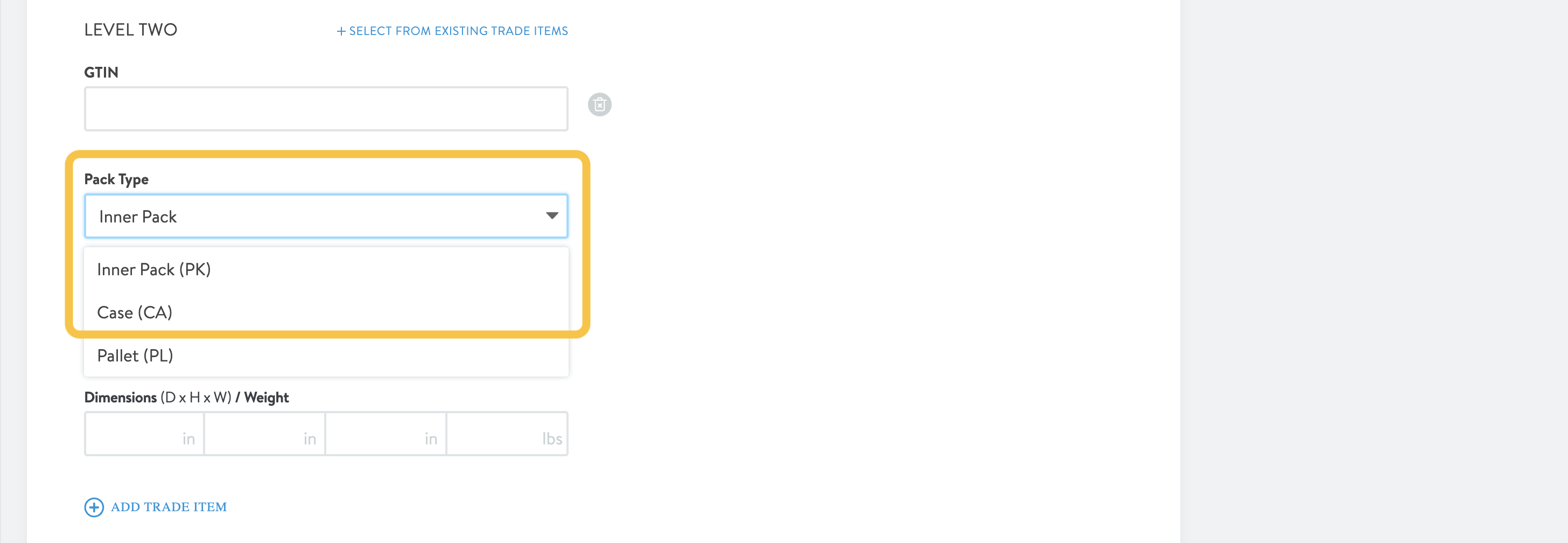Supplier Vendor and Warehouse Pack GTINs
This article explains how to convert a UPC or GTIN into a Vendor Pack GTIN or Warehouse Pack GTIN when you set up an Owned item. You may provide these GTINs when creating an item using the item setup spreadsheet or in Supplier One. If you would like to learn more about logistics, read Understanding Trade Item Configurations and Dimensions.
- Vendor Pack is also known as a Case or Supplier Pack.
- Warehouse Pack is also known as an Inner Pack.
Determine Pack Type
You must determine what type of Owned Configuration you have when you are setting up your product.
If you are setting up several items via the item setup spreadsheet, click on the Trade Item Configurations tab and scroll to the right until you see the green column headers for Required for Walmart's supply chain (only complete relevant Trade Items). There are four levels of Trade Items (Each, Inner Pack, Case, and Pallet), and you only need to fill out the Trade Items relevant for the Sellable GTIN in that row. For additional details about setting up multiple items, please refer to Set Up Items in Bulk Using a Spreadsheet.

You can set up an owned configuration directly in Supplier One using the single item setup workflow.

Or, you can create a new item configuration of an existing item directly from the Supplier One catalog (also known as cloning an item or setup by match). You may clone the GTIN of the existing item or provide a new GTIN.

When you set up a new configuration, you have to provide all of the product information. Scroll down to the Required for Walmart's supply chain (only complete relevant Trade Items) section. If you don't see "LEVEL TWO" or "LEVEL THREE", click Add Trade Item.

Open the Pack Type drop-down menu.
- To add a Warehouse Pack, select Inner Pack (PK).
- To add a Vendor Pack, select Case (CA).

Pack Definitions
Inner Pack (i.e., Warehouse Pack): A carton received in the warehouse with two or more selling units that may be separated into individual shipping units and shipped to the consumer/store.
Case (i.e., Vendor Pack): The packaged quantity of merchandise as shipped from the supplier. Follow the instructions below to create both GTIN types, depending on your shipment.
Generate a Case GTIN
- Begin with the 12-digit UPC, including the check digit. For example: 123456789123
- Remove the check digit. For example: 12345678912
- Add the prefix that most closely matches the number of items in the biggest pack you will be providing to Walmart. This could be a pallet of product or a single box. For example: 2012345678912Refer to the table below for the list of prefixes.
- Once the appropriate prefix is added, calculate a new check digit for your Case GTIN using the GS1 Check Digit Calculator. For example: 20123456789122
- Enter the 14-digit Case GTIN in your spreadsheet or directly in Supplier One.
Identify the Case Quantity
The case quantity is the total number of consumable units in the case the supplier provides to Walmart.
- The case can be an entire pallet or a single box depending on the quantity being sold to the customer.
- A pallet containing 55 cases that has 12 items per case would have a case quantity of 660.
- A case with 24 consumable units would have a case quantity of 24.
Generate the Inner Pack GTIN
The steps to generate the Inner Pack GTIN are the same as generating the Case GTIN:
- Start with the 12-digit UPC with the check digit.
- Remove the check digit.
- Add the appropriate prefix.
- Generate a new check digit.
- Enter the full 14-digit GTIN into the appropriate column of the item setup spreadsheet or directly in Supplier One. If the number has fewer than 14 digits, add zeros at the front of the GTIN.
Identify the Inner Pack Quantity
The inner pack quantity is the number of selling units within the Inner Pack. For example: If you have a total of 27 selling units and those 27 selling units are sectioned into 9 inner packs with 3 selling units inside each pack, the inner pack quantity would be 3.
Shipping Dimensions
Shipping dimensions are used for the individual selling unit that will be shipped to the customer. This is required to ensure that both the warehouse and customer are aware of the size of package being shipped/received.
Prefixes
Description | GTIN Prefix | ITF-14 barcode, Including end check digit |
Individual Item | None (UPC Only) | 123456789999 |
Inner Pack of 3 | 10 | 10123456789996 |
144 Individual Items, with 48 Inner Packs, equals 3 Case packs | 20 | 20123456789993 |
Inner Pack of 6 | 30 | 30123456789990 |
144 Individual Items, with 24 Inner Packs equals 6 Case packs | 40 | 40123456789997 |
48 Individual Items, with 16 Inner Packs, equals 3 Case packs | 50 | 50123456789994 |
30 Individual Items, with 5 Inner Packs, equals 6 Case packs | 60 | 60123456789991 |
288 Individual Items, with 48 Inner Packs of 6 | 70 | 70123456789998 |
Pallet containing 55 of 6 Case packs, with 24 Inner Packs, with 144 Individual Items | 80 | 80123456789995 |
Used for variable weight items such as food, often not allowed for standard weight items | 90 | 90123456789992 |
Pallet containing 55 of 3 Case packs, with 48 Inner Packs, with 144 Individual Items | 11 | 11123456789995 |
Pallet containing 165 of 3 Case packs, with 16 Inner Packs, with 48 Individual Items | 12 | 12123456789994 |